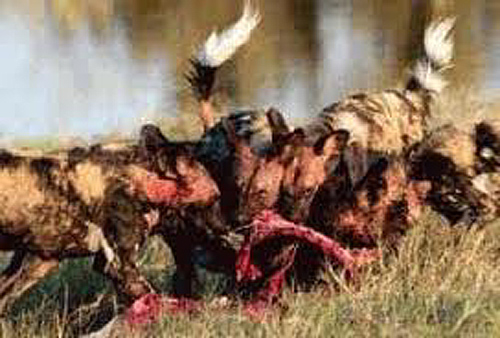
I have seen wild dogs in East Africa 6 times in the last 15 years, 5 times in the last five years and 4 times this year alone. It’s obviously getting “better.” Time to pop the champagne!
Better not.
This week’s edition of the main Arusha (Tanzania) newspaper claimed that wild dogs were now so numerous that they are routinely killing livestock, injuring herdsboys, and packs in numbers of 20 to 40 dog were now attacking people.
“There is no programme to kill them,” Mr. Dawson Urio, the chairman of Uwiro sub village told the Arusha Times this week.
Remarkable.
Dog are nimble, skilled predators. Their numbers began a near cataclysmic decline in the late 1990s, and scientists knew almost immediately why.
Human populations were increasing, and human populations had lots of pet dogs. These pet dogs were largely immune to dying from distemper, but they often got sick and were rabid transmitters of the disease. And as pet dogs increased, so did rabies.
Distemper and rabies. They were wiping out the wild dog population.
The solution was simple. Go around to all the human populations around wild dog habitats and offer to inoculate the pets free against distemper and rabies.
Guess what. It worked.
But I have to admit not even I realized how this single-minded solution begged a much greater problem, and now, we’re confronting it full on.
Much faster than lion or leopards, much smarter than elephant, wild dogs are the coyote/wolf incarnate. And while coyotes and wolves do prey on some domestic stock here at home, they have nowhere near the opportunities that wild dog do in East Africa.
Literally every wild dog habitat is surrounded by herders with pets. And there is pressure from both sides of the dividing line: the reserves are experiencing rapid predator growth and the private lands just outside are experiencing rapidly increased populations.
Moreover, Maasai in particular, are rapidly learning to breed and sell stock, rather than just accumulate them as they did in former times. This means the pressure is building even more and the food chain is rattling even louder.
The dogs are being sighted everywhere: Arusha, Kilimanjaro, the Mara, Tarangire, Tsavo… even in Kenya’s woebegone Northern Frontier which was just decimated by the drought.
Tuesday, lion researcher Shivani Bhalla reported having seen 21 wild dog just outside Samburu National Park in the Westgate Reserve.
The Northern Frontier (Laikipia) is a vast area, with a biomass much smaller than that found on the great plains like the Serengeti and the Mara. Other predators like lions and leopards generally are in much reduced numbers and confined to narrow habitat bands within protected reserves that have fairly permanent sources of water.
Perhaps, the wild dogs prospered off the corpses of the more than 60% of the livestock that was lost in the drought. Even so, I think seeing this large a group of wild dog in Samburu is extraordinary.
And few predators are as capable as the wild dog. Killing is its entire soul. Much more so than hyaena, they are cannibalistic:
Clearly we’ve got a problem. As at home where exaggerated stories of wolves and coyotes taking babies lacks any evidence, it’s going to be very easy to prove that a half dozen goats have been eaten by wild dogs.
The human/animal conflict is fast becoming the single greatest conservation issue in East Africa, today. Until now it was mostly with elephant.
No one ever expected an animal nearly written off to extinction would actually now be posing an even greater threat to man.